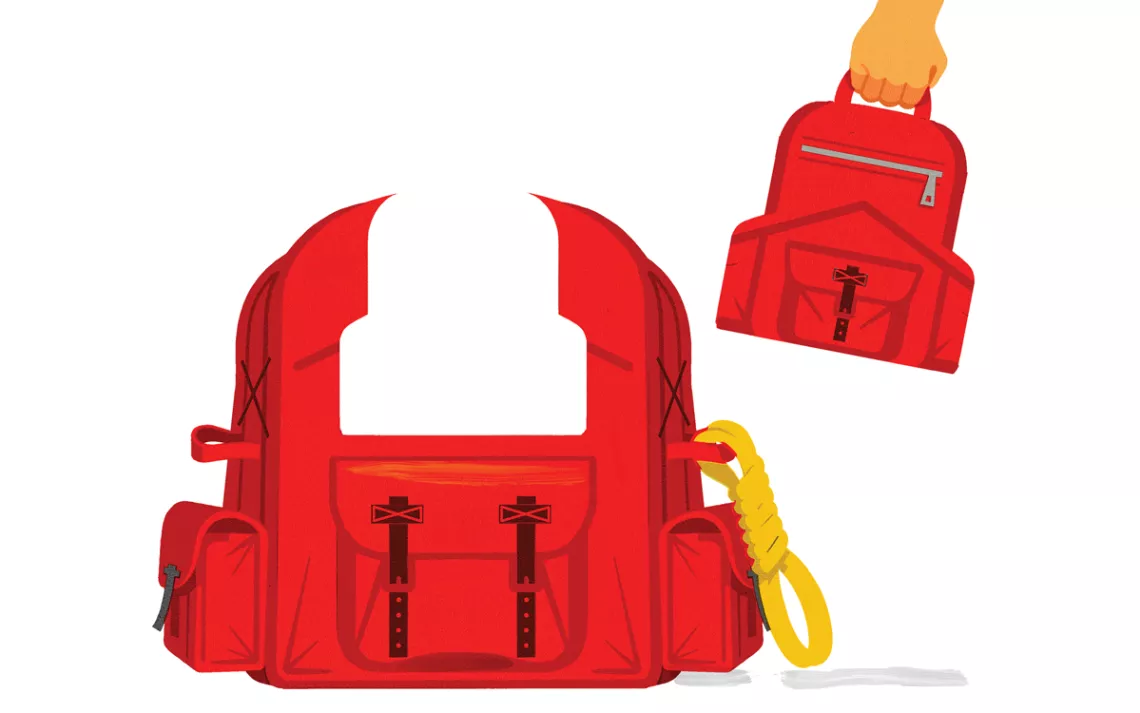Here's How to Not Buy Outdoor Gear
Sierra's guide to finding used stuff, fixing your own, and otherwise minimizing

Whatever you do, do not open my pack. If you did, you'd find loads of spare batteries, charging cords, that book on compass navigation I've never opened, Bananagrams. I've accumulated a lot of backpacking "necessities" over the years, but since my body isn't getting any younger, and my trail aspirations continue to broaden, I'm slowly learning that less is more. Nowadays, I try to leave much of what I used to pack at home. I've noticed that when I don't overpack, I don't overpurchase. Here are some strategies to help you resist buying new gear and minimize your landfill contributions.
Check Out Lending Ecosystems
Building your own collection of outdoor gear can be expensive—and space-consuming. Which isn't to say you shouldn't keep trying new adventures; rather, acquaint yourself with gear-borrowing systems. Here are some noteworthy models.
- REI
The outdoor-gear-and-apparel co-op has rental shops at stores in 29 states. The selection varies at each location but generally includes car racks as well as goods for camping, hiking, climbing, cycling, paddling, and snow sports.
- Katahdin Gear Library
This Millinocket, Maine–based operation is part of the local library. Maine residents can check out mountain bikes, backpacks, kayaks, paddleboards, canoes, skis, snowboards, and fat-tire bikes for up to a week, free of charge.
- Washington Trails Association
This trail-maintenance-and-advocacy nonprofit hosts outdoor-leadership-training workshops for adults looking to take youths hiking, snowshoeing, and camping. After the training, trip leaders have access to a first-come, first-served gear library.
- Bay Area Wilderness Training
Graduates of this organization's outdoor-leadership-training programs gain access to backpacking, camping, and snowshoeing gear for free or at a low cost. Youth groups and schools can borrow from three Northern California libraries.
- Families in Nature
This central Texas nonprofit's mission is to connect families with the outdoors for nominal fees (waived for some). It lends backpacking equipment to families, schools, and organizations with complementary missions.
- Outdoors Empowered Network
If your youth group or school wants to start a gear library, Outdoors Empowered Network—a nonprofit focused on creating more equitable outdoor access—has you covered. OEN provides fundraising assistance, help in developing training programs and acquiring outdoor equipment, and gear-library design services.
Shop With Companies That Repair or Restore Their Gear
Most reputable gear manufacturers make stuff to last. But inevitably, some of that gear will fail from normal wear and tear and accidents. Conscientious consumers can do their part by trying to repair items rather than tossing them. A growing cadre of companies offer services, from spare-part repair to all-out restoration. The exact terms vary for each brand, so the fine print is worth reading. Here are a few standouts.
- Big Agnes
This manufacturer's website has a slew of DIY repair guides for fixing your tent, sleeping bag, or sleeping pad at home. You can mail in busted zippers and tent shock cords; Big Agnes will repair gear for about $4 to $20 and send it back within a couple of weeks.
- Cotopaxi
This maker of clothing and packs offers a lifetime guarantee—with a few caveats (if an animal has chewed it, for instance, all bets are off). Cotopaxi will help you fix the item at home by sending gear tape, buckles, or zipper pulls for free.
- Osprey
Even if you made your purchase decades ago and have no receipt, Osprey will fix or replace your busted zipper or torn pack—no fine print, no questions asked, and no charge for repairs. The customer pays for shipping only.
- Gore-Tex
Though you'll have to hang on to your receipt to benefit, this waterproof-gear maker offers mail-in repair through authorized retailers. Gore-Tex recommends bringing Tenacious Tape into the field for temporary fixes. Never use duct tape on any gear—it doesn't work, and in this case, it voids your warranty.
- Cascade Designs
The parent company of MSR and Therm-a-Rest runs a repair shop for fixing tent and sleeping bag zippers, tent poles, and punctured sleeping pads. Cascade's website features gear-repair videos and a replacement-parts menu (tent poles are free!).
- Patagonia
Send broken and worn goods in for repair at a "reasonable charge." Patagonia also has a library of repair videos on its site—get maintenance and repair pointers on how to depill sweaters, patch down jackets, and fix zipper sliders and buckles.
Think Hard Before You Buy (and Pack)
Each season's array of inflatable solar lanterns, travel coffee presses, and backpack-cooler combos is tantalizing. But aim your wallet at products that show true safety and efficacy advancements. Better yet, hang on to your gear that's stood the test of time.
When packing for an adventure, coordinate gear with tripmates (digitally catalog everyone's contributions). Also, stick to the "10 essentials" of critical survival items: navigation tools, a headlamp, sun protection, first aid, a knife and repair kit, fire-starting tools, a shelter, and extra food, water (or purification tools), and clothes.
Fixing Your Own Gear
Expert repairer Kyle Wiens says he's always had a knack for fixing things. "I come from a family of tinkerers," says Wiens, who cofounded the repair-anything website iFixit and is a prominent advocate in the Right to Repair movement. Wiens, also an avid backpacker and Eagle Scout, has fiddled with and mended all manner of outdoor gear. Here are his tips for navigating these fixes at home and in the field.
In addition to buying from manufacturers that offer replacement parts and/or have a gear-repair program, aim to buy products that you can fix yourself. Look for bolts or screws, which indicate that an item can be deconstructed (as opposed to permanent rivets). Does the product have basic parts that can be replaced easily, like standard buckles, buttons, patches, and zippers?
Before you take items on a trip, learn some fundamental fixes in case something goes wrong, like sewing stitches, especially if you won't have internet access where you're going. If you're in the backcountry, you may not be able to access sites like YouTube or iFixit for instructions.
Carry a repair kit with the basics: sewing supplies, an awl (for sewing durable fabrics like canvas), and waterproof gear tape.
In general, be willing to tinker and be curious about your gear, rather than throwing it out as soon as something breaks or wears down.
This article appeared in the Summer quarterly edition with the headline "How to Not Buy Outdoor Gear."
For more tips on how to minimize purchases and extend your gear's life, go to sc.org/less-gear.
 The Magazine of The Sierra Club
The Magazine of The Sierra Club



